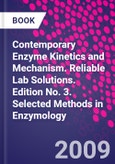Kinetic studies of enzyme action provide powerful insights into the underlying mechanisms of catalysis and regulation. These approaches are equally useful in examining the action of newly discovered enzymes and therapeutic agents.
Contemporary Enzyme Kinetics and Mechanism, Second Edition presents key articles from Volumes 63, 64, 87, 249, 308 and 354 of Methods in Enzymology. The chapters describe the most essential and widely applied strategies. A set of exercises and problems is included to facilitate mastery of these topics.
The book will aid the reader to design, execute, and analyze kinetic experiments on enzymes. Its emphasis on enzyme inhibition will also make it attractive to pharmacologists and pharmaceutical chemists interested in rational drug design. Of the seventeen chapters presented in this new edition, ten did not previously appear in the first edition.
Please Note: This is an On Demand product, delivery may take up to 11 working days after payment has been received.
Table of Contents
Section 1: Initial Rate Theory & Methods 1. Derivation of Initial Velocity and Isotope Exchange Rate Equation (Huang) 2. Practical Considerations in the Design of Initial Velocity Enzyme Rate Assays (Purich) 3. Techniques in Coupled Enzyme Rate Assays (Rudolph) 4. Regression Analysis, Experimental Error, and Statistical Criteria in the Design and Analysis of Experiments for Discrimination between Rival Kinetic Models (Mannervik) 5. Analysis of Enzyme Progress Curves by Nonlinear Regression (Duggleby) 6. Effects of pH on Enzymes (Tipton) 7. Temperature Effects on Enzyme Kinetics (Laidler) 8. Site-Directed Mutagenesis: A Tool for Studying Enzyme Catalysis (Plapp) 9. Cooperativity in Enzyme Function: Equilibrium and Kinetic Aspects (Neet)
Section 2: Inhibitors as Probes of Enzyme Catalysis 10. Reversible Enzyme Inhibitors as Mechanistic Probes (Fromm) 11. Application of Affinity Labeling for Studying Enzyme Structure and Function (Plapp) 12. Mechanism-Based Enzyme Inactivators (Silverman)
Section 3: Detection of Enzyme Reaction Intermediates 13. Transient Kinetic Approaches to Enzyme Mechanisms (Hammes) 14. Rapid Quench Kinetic Analysis of Polymerases, Adenosinetriphosphatases, and Enzyme Intermediates (Johnson) 15. Pre-Steady-State Kinetics of Enzymatic Reactions Studied by Electrospray Mass Spectrometry with Rapid On-Line Techniques (Konermann)
Section 4. Isotopic Probes of Enyme Processes 16. Isotope Exchange Methods for Elucidating Enzyme Catalysis (Purich) 17. Positional Isotope Exchange as Probes of Enzyme Action (Raushel) 18. Enzymatic Transition State Analysis and Transition State Analogues (Schramm) 19. Determining Transition-States from Kinetic Isotope Effects (Berti) 20. Computational Methods for Transition State and Inhibitor Recognition (Schwartz)








